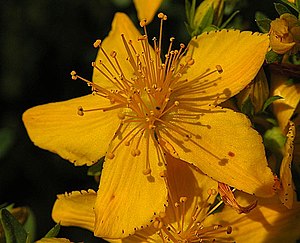
- Image via Wikipedia –Hypericum perforatum
Saint John’s wort, Hypericum perforatum, is a member of the St. Johnswort family, Hypericaceae. It’s native to Europe, but now naturalized in North America, Australia – where it’s grown for medicine, and elsewhere. To distinguish it from other members of the family, it’s often called Common St. John’s Wort.
St. John’s wort is a roadside weed that grows in fields and waste areas. It can form great colonies in areas receiving abundant sunlight. In some areas it grows so well that it is considered an invasive weed. This is to the dismay of cattle ranchers and herders because livestock can be sickened by consuming this weed. It’s a perennial herb that grows one to two feet tall. The aerial parts die back to the ground in winter and the perennial root system sends up new shoots the following spring.
The leaves form a cross pattern when viewed from above with two oblong oval leaves opposite one another and perpendicular to the leaf set above and below them. The leaves are stalkless and entire with bluntly rounded ends. Oil spots can be seen as translucent areas in leaves held up to the light, thus the Latin name, perforatum.
Bright yellow flowers occur in branched, terminal clusters. Each radially symmetrical blossom is about an inch across and has five separate petals. Each petal has conspicuous black dots near the edges. Numerous stamens in three clumps make the blossoms appear bushy. St. John’s wort is so named for it blooms about June 24th on Saint John the Baptist’s birthday. The plant is harvested at this time for the flowering tops that are used in herbal teas or extracts. The blooming period lasts all summer until fall.
The flowers and stems can be used to make yellow and red dyes. The seed pods, which are oval reddish-brown capsules, are used to make a red dye.
Externally, a wash with St. John’s wort is used to clean wounds and speed healing of cuts, sores and bruises. It has antibiotic and anti-inflammatory properties. It’s also used as a hair rinse after shampooing.
St. John’s wort is likely effective against mild to moderate depression, but it may not work for all kinds of depression. It improves mood and reduces anxiety and insomnia related to depression. It’s often prescribed in Germany for this reason. An herbal tea or oil extract may act as a mild tranquilizer and muscle relaxant to exert its beneficial activity. It may take up to three months of using the herb to feel the effects.
The constituents hypericin, pseudohypericin and hyperforin may be the active ingredients for the sedative, anti-inflammatory, antibacterial and anti-viral properties noted experimentally. It has serious side-effects and may make other drugs more or less potent when taken together. Photosensitivity is a possible outcome of taking this herb either internally or externally.
